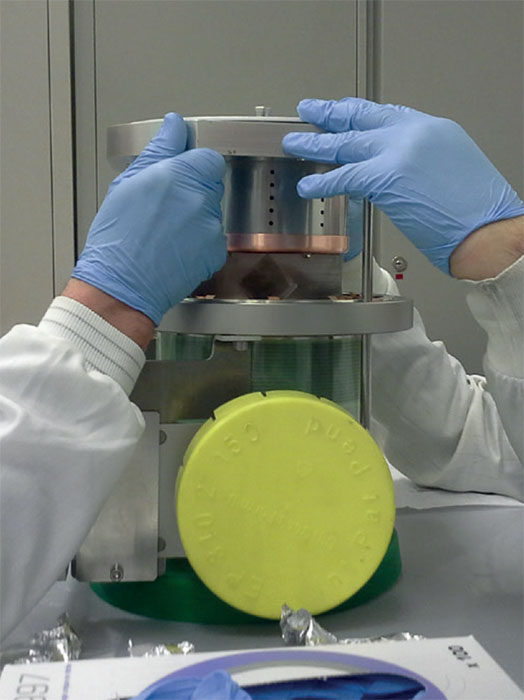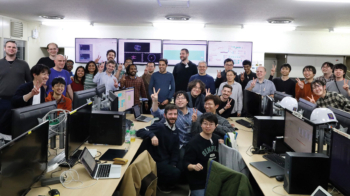Detectors will probe the quartic couplings of electroweak bosons.

Image credit: Sergio Cittolin.
As its name suggests, the Large Hadron Collider (LHC) at CERN smashes hadrons into one another – protons, to be precise. The energy from these collisions gets converted into matter, producing new particles that allow us to explore matter at the smallest scales. The LHC does not fire protons into one another individually; instead, they are circulated in approximately 2000 bunches each containing around 100 billion protons. When two bunches are focused magnetically to cross each other in the centre of detectors such as CMS and ATLAS, only 30 or so protons actually collide. The rest continue to fly through the LHC unimpeded until the next time that two bunches cross.
Occasionally, something very different happens. If two protons travelling in opposite directions pass very close to one another, photons radiated from each proton can collide and produce new particles. The two parent protons remain completely intact, continuing their path in the LHC, but the photon–photon interaction removes a fraction of their initial energy and causes them to be slightly deflected from their original trajectories. By identifying the deflected protons, one can determine whether such photon interactions took place and effectively turn the LHC into a photon collider. It is also possible for the two protons to exchange pairs of gluons, which is another interesting process.
The idea of tagging deflected protons has been pursued at previous colliders, and also at the LHC back in 2012 and 2015 using only low-intensity beams. The proposal to pursue this type of physics with the LHC’s CMS and/or ATLAS experiments was first presented many years ago, but the project (under the name FP420) did not materialise.
A new project called the CMS-TOTEM Precision Proton Spectrometer (CT-PPS) has now taken up the challenge of making photon–photon physics possible at the LHC when operating at nominal luminosity. While CMS is a general-purpose detector for LHC physics, CT-PPS uses two sets of detectors placed 200 m either side of the CMS interaction point to measure protons in the forward direction. A parallel project called ATLAS Forward Physics (AFP) is also being developed by ATLAS, and both experiments aim to be in operation throughout this year’s LHC proton–proton run.
Light collisions

Despite photons being electrically neutral, the Standard Model (SM) allows two photons to interact via the exchange of virtual charged particles. Several final states are possible (figure 1), including a pair of photons. The latter process (γγ → γγ, or “light-by-light scattering”) has been known since the development of quantum electrodynamics (QED) and tested indirectly in several experiments, but the first direct evidence came last year from ATLAS in low-luminosity measurements of lead–lead collisions (CERN Courier December 2016 p9). Since the probability of emitting photons scales with the square of the electrical charge, the cross-section for lead–lead collisions is significantly higher than for proton–proton collisions. By searching for two photons and nothing else in the central detector and using kinematics cut to suppress backgrounds, the invariant mass of the two photons was in the region of 10 GeV. The measured cross-section was compatible with the QED prediction and, since no deviations are expected in this low-mass range, the ATLAS result was interesting but somewhat expected.
In forward experiments such as CT-PPS and AFP, however, the high-luminosity proton collisions allow a much higher mass region to be probed – between 300 GeV and 2 TeV in the case of CT-PPS. Proton tagging is possible because centrally produced high-mass systems cause the protons to lose enough energy to be deflected into the CT-PPS detectors. The study of photon interactions in this region could therefore provide new insights about the electroweak interaction, in particular the quartic gauge couplings predicted by the SM. These are interactions where two photons annihilate upon collision to produce two W bosons, implying four particles at the same vertex in a Feynman diagram (figure 1). Deviations from the SM prediction would point to new physics in the same way as the observations of deviations from the quartic coupling in Fermi’s beta-decay theory in the 1930s were the forerunner to the discovery of the W boson 50 years later.

Image credit: CERN.
If there are new particles with masses above 300 GeV, CT-PPS could also improve CMS’s general discovery potential. For example, diphoton resonances at high mass have a very clean signature almost free of any background. Thus, in addition to precision electroweak tests, forward experiments such as CT-PPS provide an important cross-check of “bumps” in invariant mass distributions by offering complementary information about the production mechanism, coupling and quantum numbers of a possible new resonance. An example of this complementarity concerns the now-infamous 750 GeV bump in the diphoton invariant-mass distributions from the LHC’s 2015 data set. Although the bump turned out to be a statistical effect, it provided strong motivation to advance the CT-PPS physics programme at the time. Were similar bumps to be observed by CMS and ATLAS in future, CT-PPS and AFP will play an important role in determining whether a real resonance is responsible for the excesses seen in the data.
Forward thinking
Given their potential for revealing new physics, photon–photon collisions have been a topic of some interest for many decades. For example, photon–photon collisions were studied at CERN’s Large Electron Positron (LEP), while studies at DESY’s HERA and Fermilab’s Tevatron colliders concentrated on interactions of protons through the exchange of gluons to probe quantum chromodynamics in the non-perturbative regime. The LHC achieves a much higher energy and luminosity than LEP, but at the price of colliding particles that are not elementary. Therefore, the elementary interactions between gluons and quarks do not have well-defined energies and the interaction products include the remnants of the two protons, making physics analyses more difficult in general.
Proton-tagged photon collisions at the LHC, on the other hand, are very clean. Since photons are elementary particles and there are no proton remnants, the photon–photon collision energy at the LHC is precisely defined by the kinematics of the two tagged protons. In conjunction with CT-PPS, CMS can therefore probe anomalous quartic couplings with much better sensitivity than before.

Image credit: CERN.
The physics we are interested in corresponds to the process pp → ppX, where the “pp” part is measured by the CT-PPS detectors and the system “X” is measured in the other CMS sub-detectors. In the case of the quartic coupling γγWW, for instance, the process is pp → ppWW. The two photons that merge into two W are not measured directly, but energy-momentum conservation allows all of the kinematic properties of the WW pair to be deduced much more precisely from the CT-PPS proton measurements than could be achieved from the measurements of W decay products with the CMS detector alone.
The CT-PPS detectors are located on either side of CMS, 200 m from the interaction point. They rely on objects called Roman Pots (RP), which are cylinders that allow small detectors to be moved into the LHC beam pipe so that they sit a mere few mm from the beam. The RPs of TOTEM are designed to operate under special LHC runs with a small number of collisions per second. However, the physics goals of CT-PPS require the RPs to operate during normal CMS data-taking, when the LHC provides a much higher number of collisions per second. The first and most important goal of the CT-PPS project was therefore to demonstrate that the detectors could operate successfully only a few millimetres from the LHC’s high-intensity beams. The final demonstration happened between April and May 2016, and the green light for CT-PPS operation in regular high-luminosity LHC running was given the following month.
Success so far
The CT-PPS project redesigned the RPs to suit these harsh operating conditions. In collaboration with LHC teams, they also conducted a thorough programme of RP insertions at increasingly closer distances to the beam, measuring its impact on beam monitors. Great care must be taken not to disrupt the beam, since if the protons start to scrape the RPs there would be an increase in secondary particles that would trigger a beam dump. In 2016, CT-PPS used non-final detectors to collect 15.2 fb–1 of data integrated in the CMS data set. CT-PPS has proven for the first time the feasibility of operating a near-beam proton spectrometer at high luminosity on a regular basis and has paved the way for other such spectrometers.

Image credit: CERN.
CT-PPS is also facing big challenges in the development of the final detectors. The tracking detectors have a surface area of just 2 cm2 and reside in two RPs located 10 m apart on either side of the collision point (for a total of four stations). Six planes of silicon pixels on each station will detect the track of the flying protons to provide direction information, and the magnetic field of the LHC’s magnets will serve as the proton-deflecting field. The devices themselves have to sustain exceedingly high radiation fluxes given their proximity to the beam: a proton fluence in excess of 5 × 1015 particles/cm2 is expected after an integrated luminosity of 100 fb–1. CMS’s own tracker will not face these radiation conditions until the HL-LHC enters operation in the mid 2020s.
From 2017 onwards, CT-PPS will be using new 3D pixel technology that has been developed in view of upgrades to the CMS tracker and therefore provide valuable experience with the new sensors. The project also relies on high-precision timing detectors. CT-PPS matches the primary vertex of the collision measured in the central detector with the vertex position obtained from the difference of the time-of-arrival to the two protons, so that it can reject the background from spurious collisions piling up in the same bunch crossing. A time precision of 20 ps makes it possible to estimate the z-vertex with the 3 mm accuracy needed to reduce the background sufficiently. The timing detectors had used diamond sensors in 2016 and will add silicon low-gain avalanche diodes this year. Again, the experience acquired in a high-rate and high-radiation environment will be most valuable for CMS upgrades for HL-LHC.
Meanwhile, the ATLAS collaboration installed one arm of the AFP experiment in early 2016 and has taken data in special low-luminosity runs to study diffraction. The second AFP arm, with horizontal RP stations similar to those of CT-PPS, has also since been installed and its four-layer 3D silicon pixel detectors and new Cherenkov-based time-of-flight detectors are being assembled. They will be installed and commissioned before the LHC restarts in May this year. Like CT-PPS, AFP aims to participate in high-luminosity running throughout the year, with both operating in tandem to enhance the LHC’s search for new physics.





